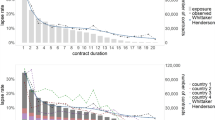Abstract
Modeling event counts is important in many fields. For this purpose, the Poisson regression model is often used. However, this model assumes the equidispersion of the data. Unfortunately, this assumption is often violated in the observed data. The source of overdispersion depends on many situations. When the source of overdispersion is the excess of zeroes, the Zero-inflated Poisson regression model fits better counts data. In this paper, we first review the theoretical framework of Poisson regression and Zero-inflated Poisson regression. The probability integral transform test and the Vuong’s test are used to compare between the two models. Second, we fit these models to the number of claims in a private health insurance scheme. In our case, the number of claims is overdispersed because of the preponderance of zeroes in the data set. The results prove that Zero-inflated Poisson regression performs better the number of claims of the customers affiliated in the health insurance scheme in the Moroccan case.



Similar content being viewed by others
References
Agresti A (1996) An introduction to categorical data analysis. Wiley, NewYork
Anderson D, Feldblum S, Modlin C, Schrimacher D, Schirmacher E, Thandi N (2004) Practitioner’s guide to generalized linear models: a foundation for theory, interpretation and application. Watson Wyatt
Cameron AC, Trivedi PK (1986) Econometric models based on counts data: comparisons and applications of some estimators and tests. J Appl Econom 1(1):29–53
Cameron AC, Trivedi PK (1990) Regression-based tests for overdispersion in the Poisson model. J Econom 46(3):347–364
Czado C, Gneiting T, Held L (2009) Predictive model assessment for count data. Biometrics 65:1254–1261
Dawid AP (1984) Statistical Theorie: the prequential approach. J Royal Stat Soc Ser A Gen 147:278–292
Dean C, Lawless JF (1989) Tests for detecting overdispersion in poisson regression models. J Am Stat Assoc 84(406):467–472
Greene W (2002) Econometric analysis. Prentice Hall, USA
Gurmu S (1991) Tests for detecting overdispersion in the positive poisson regression model. J Bus Econ Stat Am Stat Assoc 9(2):215–222
Hall DB (2000) Zero-inflated Poisson and binomial regression with random effects: a case study. Biometrics 56:1030–1039
Hall DB, Shen J (2010) Robust estimation for zero-inflated Poisson regression. Scand J Stat 37:237–252
Hausman JA, Hall DB, Griliches Z (1984) Econometric models for counts data with an application to the patents-R&D relationship. Econometrica 52:909–938
King G (1989) A seemingly unrelated poisson regression model. Sociol Methods Res 17:235–255
King G (1989) Variance specification in event count models: from restrictive assumptions to a generalized estimator. Am J Political Sci 33:762–784
Lambert D (1992) Zero-inflated Poisson regression, with an application to defects in manufacturing. Technometrics 34:1–14
Lee L (1986) Specification tests for poisson regression models. Int Econ Rev 27:689–706
Long JS (1997) Regression models for categorical and limited dependent variables. Sage Publications, Thousand Oaks
McCullagh P (1983) Quasi-likelihood functions. Ann Stat 11:59–67
McCullagh P, Nelder J (1989) Generalized linear models. Chapman & Hall, London
Miller JM (2007) Comparing Poisson, Hurdle and ZIP model fit under varying degrees of skew and zero-inflation. PhD Thesis, University of Florida, Gainesville, Florida, USA
Mouatassim Y, Ezzahid E, Belasri Y (2012) Operational Value-at-Risk in Case of Zero-inflated Frequency. Int J Econ Finance 4(6):70–77
Nixon DC (1991) Event count models for supreme court dissents. Political Methodol 4:11–14
Smith JQ (1985) Diagnostic checks of non-standard time series models. J Forecast 4:283–291
Vuong QH (1989) Likelihood ratio tests for model selection and non-nested hypotheses. Econometrica, 307–334
Zorn CJW (1996) Evaluating zero-inflated and hurdle Poisson specifications. Presented at Midwest Political Science Association, USA
Author information
Authors and Affiliations
Corresponding author
Rights and permissions
About this article
Cite this article
Mouatassim, Y., Ezzahid, E.H. Poisson regression and Zero-inflated Poisson regression: application to private health insurance data. Eur. Actuar. J. 2, 187–204 (2012). https://doi.org/10.1007/s13385-012-0056-2
Received:
Revised:
Accepted:
Published:
Issue Date:
DOI: https://doi.org/10.1007/s13385-012-0056-2




